 |
||
|
||
| ||
 Today we will continue speaking about GeForce3 cards flourishing in the warm sun on the computer market (here is the previous article). This processor, which embarrassed many testers, caused a scornful smile n the faces of many users looking at tags of $500-600, knocked out impressed users that saw how it operated in technology demo programs, this King in the 3D-world - GeForce3 has at last arisen! Or rather cards based on it have at last appeared on the retail market! The NVIDIA's PR has done its best to make users want to buy their $400 video cards in the short time these cards have been on the market. Have you ever seen anything like this before, even for cards priced much lower? I doubt it. Today we will speak about some peculiar features of this card and consider some aspects of GeForce3 left aside in the ASUS AGP-V8200 Deluxe review. Now a study of any new chip will consist of a number of parts, i.e. articles of cards based on this chip. So, be aware the video section where you can now find abstracts of reviews of video cards based on the latest NVIDIA processor - we will specify what aspects are given special attention in one or another article. Each review is a separate article where you can get the complete idea on the product in question. Note that the basic theory behind the GeForce3 is concentrated in a series of our first reviews on this GPU. You can read about peculiarities of video cards on this processor and how they run the latest benchmarks:
And now I'm coming to the review of the Leadtek WinFast GeForce3 card. CardThe Leadtek WinFast GeForce3 has AGP x2/x4 interface, 64 MBytes DDR SDRAM located in 8 chips on the right side of the PCB. 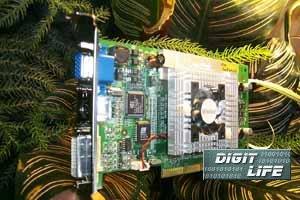 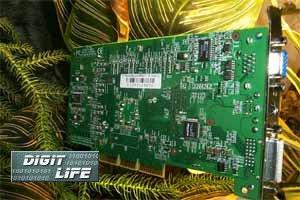 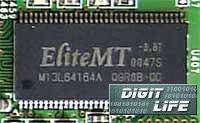 EliteMT produces memory chips with 3.8 ns access time which corresponds to 260 (520) MHz. The memory, however, works at 230 (460) MHz. We have already seen this frequency in GeForce2 Ultra cards, but that time 4 ns memory chips were used. You can see that the developers decided to play it safe not only by installing heat sinks on the memory modules but also by lowering the frequency down to 230 (460) MHz. The card's design completely follows the reference one from NVIDIA, which we have already seen on the pre-production samples (the card's appearance doesn't differ from that of its predecessor on the A03-stepping of the CPU GeForce3, except the heat sinks on the memory modules). 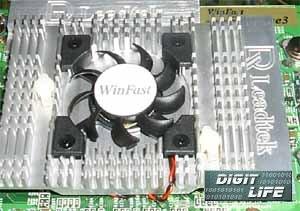 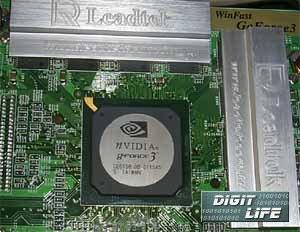 First of all, my eye is caught by a massive silver-colored cooling system. The only difference from the Leadtek WinFast GeForce2 Ultra lies in the way the heat sinks are mounted on the memory chips. Whereas earlier there was a spring, in the case of the Leadtek WinFast GeForce3 the heat sinks are glued to the memory modules (the new reference design doesn't provide holes for such coolers). In the new design the memory modules are located closer to the GPU, that is why side heat sinks are partially covered by the central one. And even the WWW-address of the company's site (on the photo in the upper right) is hiding under the huge central heat sink. This type of the GPU cooling device is typical of Leadtek cards nearly a year already, since the release of GeForce2 GTS cards. I'm just surprised how perfectly such flat, finless heat sinks on memory chips cope with their task. 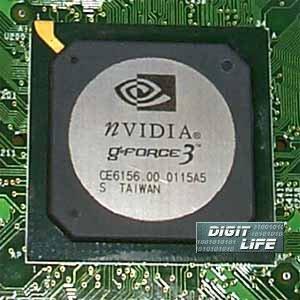 This card is equipped with a GPU marked as GeForce3, and not as NV20, as we could see earlier on the pre-production samples. The marking says that the processor has A05 stepping, and it was produced on the 15th week of 2001 (in the middle of April). Further, the card is equipped with a TV-out with a S-Video connector and a DVI for connecting monitors with a digital interface. The card is bright green. The previous citrus-yellow color which distinguished cards of this company is now gone. Today all video cards except previous GeForce2 ones are green. 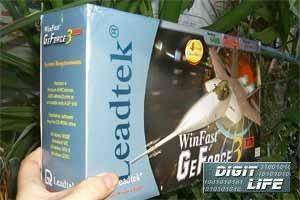 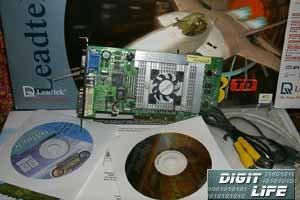 The card is shipping in a Retail-package of a bit unusual coloring. The box contains:
OverclockingThe Leadtek WinFast GeForce3 has reached a maximum of 240/270 (540) MHz. It is not an absolute record among GeForce3 video card in mass production, since the earlier studied ASUS AGP-V8200 Deluxe has achieved the same values. It is interesting that both the chip and the memory of two different cards behave equally when overclocked: at 247 MHz for the processor and 548 MHz for memory there were some artifacts. That is why the frequencies were decreased so as not to exceed the safe level. Note that the additional cooling should be provided when overclocking the card! Installation and driversTest system configuration:
ViewSonic P810 (21") and ViewSonic P817 (21") monitors were used. For testing we used drivers from NVIDIA of 12.00 version, VSync was off. For comparison the results of the following cards are shown:
The video card is supplied with the latest drivers from Leadtek based on the NVIDIA 12.00 ones. The software contains a proprietary utility WinFox allowing for adjustment of the card's operation. We have already spoken about this utility, but anyway, let's look at it once again: 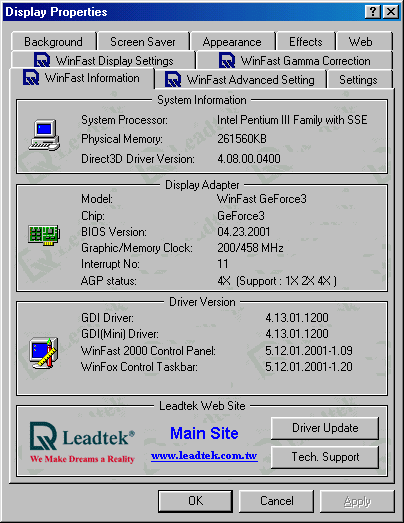 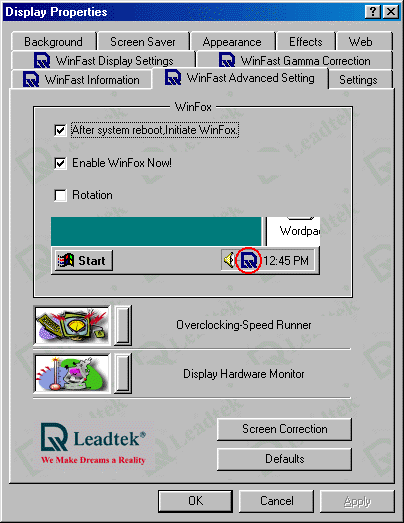 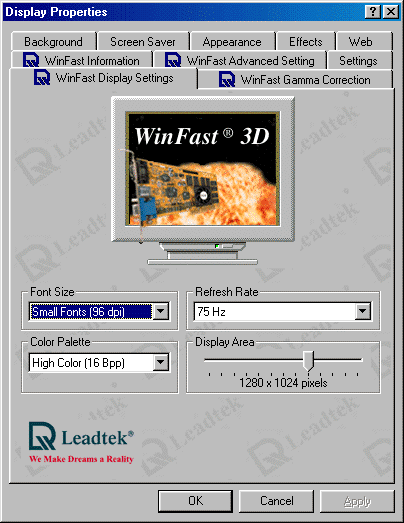 The major settings are shown above, so is the information on the drivers and the card itself. The WinFox contains an overclocking program Speed Runner: 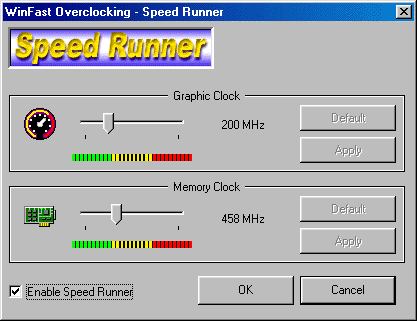 All functions can be enabled via a dispatcher, which can be, in its turn, easily enabled by clicking an icon below on the right (note that the card is lacking the ability to perform Hardware Monitoring): 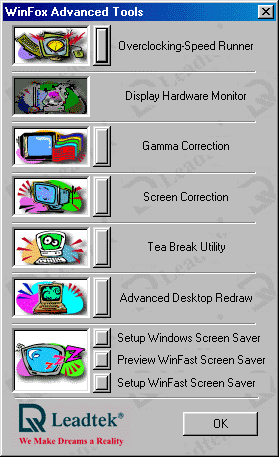 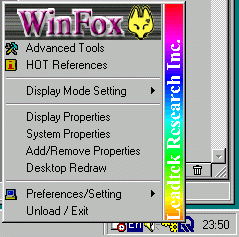 Advanced users who want to enable some functions not included in the NVIDIA drivers should refer to the RivaTuner of Aleksei Nikolaychuk described in the ASUS AGP-V8200 Deluxe review. Test resultsI should note that the Leadtek WinFast GeForce3 has perfect 2D quality, not worse than that of the ASUS AGP-V8200 Deluxe. In 1600X1200 resolution at 75 or even 85 Hz one can work comfortably with a large monitor. As always, the Leadtek shows excellent quality in the layout of the card and the components of the output circuits. Now comes 3D performance. Here we used the following programs:
Quake3 Arenademo002The tests were carried out in two modes: Fast (shows card's work in 16-bit color) and High Quality (shows card's work in 32-bit color). 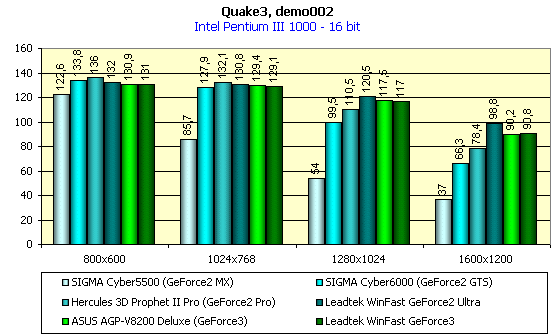 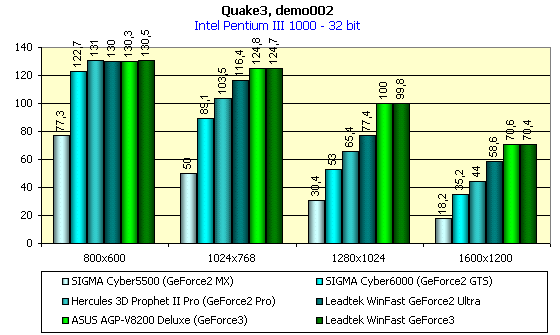 This test is intended both to show the position of the GeForce3 in a series NVIDIA chipset and to show whether the Leadtek WinFast GeForce3 performs as do other cards in its class. We will compare the card with the ASUS AGP-V8200 Deluxe which proved to have characteristics corresponding to the GeForce3 cards' class. The diagrams above show there is no difference between the Leadtek WinFast GeForce3 and the reference card. Besides, in 16-bit color the GeForce3 lags behind the predecessor GeForce2 Ultra, but in 32-bit color it takes the lead. Here we have already considered the GeForce3 operation in Quake3 at the maximum quality, as well as analyzed the scalability (performance that depends on the CPU frequency) and anti-aliasing. OverclockingConsidering the fact that the Leadtek WinFast GeForce3 has shown the same overclocking potential as the ASUS AGP-V8200 Deluxe, it makes sense to read about it in the corresponding review. 3DMark2001This benchmark contains several game tests and some functional ones. We will touch only upon the game test results since functional performance was tested in full previously with the 3DMark2001 benchmark. Note that the scenes are very complex, with a lot of effects. The card will be tested only in High Detail mode with the D3D Pure Hardware T&L enabled. But the most interesting test will be studying of the anisotropic filtering in Direct3D (with 8 texture samples enabled) which can be activated via the latest RivaTuner. GAME1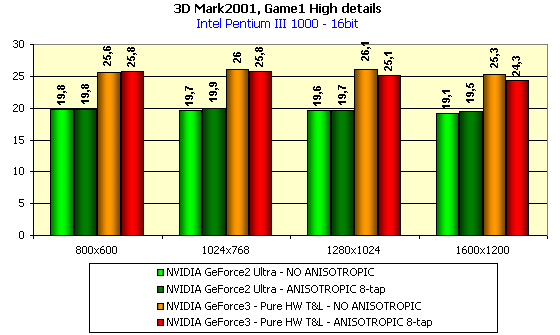 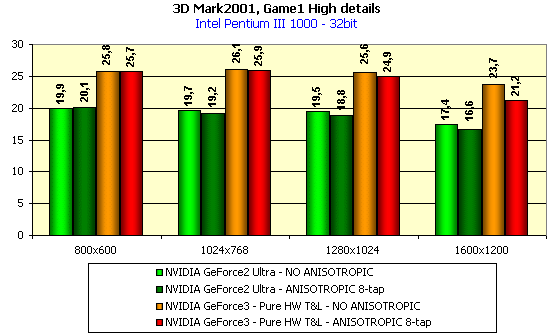 You can see that the GeForce3 easily beats its predecessors. At high resolutions where the processor doesn't play a vital role, the performance drops when anistropic filtering is enabled. And what about the quality of the filtering? Bilinear filtering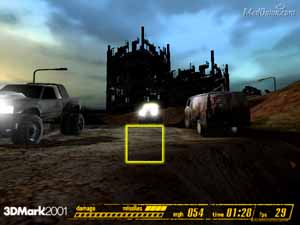  Anisotropic filtering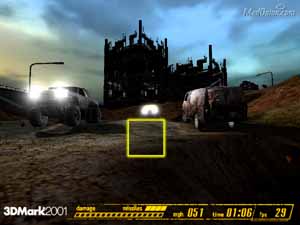  Bilinear filtering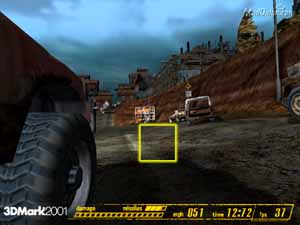  Anisotropic filtering  The quality has improved a bit. The textures are sharp all along the whole picture. GAME2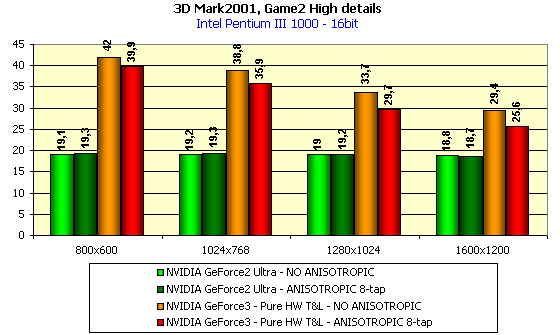 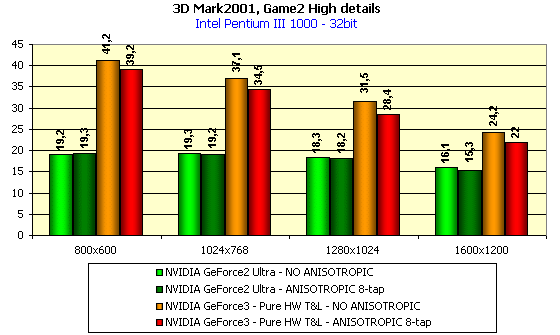 In this case there are performance drops when anistropic filtering is enabled. Let's look at the quality: Bilinear filtering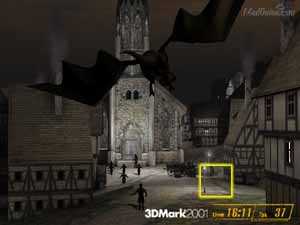  Anisotropic filtering  Again the quality has taken a turn for the better. It is not, certainly, a 32-sample anisotropy that can be seen in OpenGL-applications, anistropic filter that can be seen in OpenGL applications, but this level of improved quality is good enough. GAME3 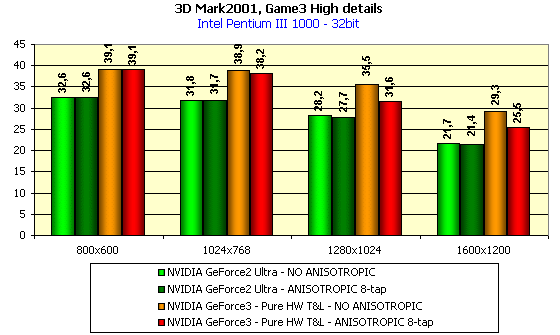 And here the performance drops significantly with
the anisotropic filter enabled, while in case of the GeForce2 Ultra
it is nearly absent. GAME4 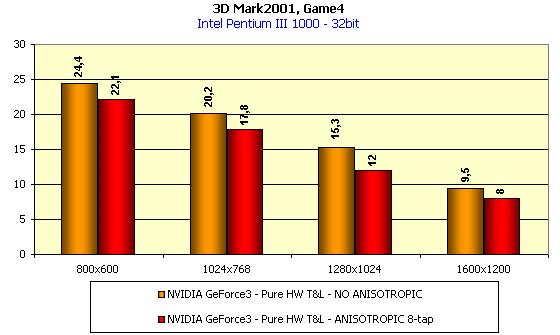 In this test the performance also drops by a great margin. GLMarkThis benchmark was released by Vulpine right before the widely advertised 3DMark2001 from MadOnion. It differs from the latter not only in API (GLMark works in OpenGL), but also in GeForce3 support. While the 3DMark2001 enables the DirectX 8.0 support, the GLMark uses the defined OpenGL extensions brought in by NVIDIA in its ICD for making interesting effects like EMBM. In case of other video cards such effects will be impossible to get: NVIDIA GeForce2 Ultra     That is why in the graphs below all results concerning the GeForce3 are obtained at the maximum quality, i.e. with the corresponding OpenGL extensions enabled. With the data obtained I have drawn the graphs of the performance in FPS vs. time. We have also read the results of the overclocked Leadtek WinFast GeForce3. Let's consider it in different resolutions: 800x600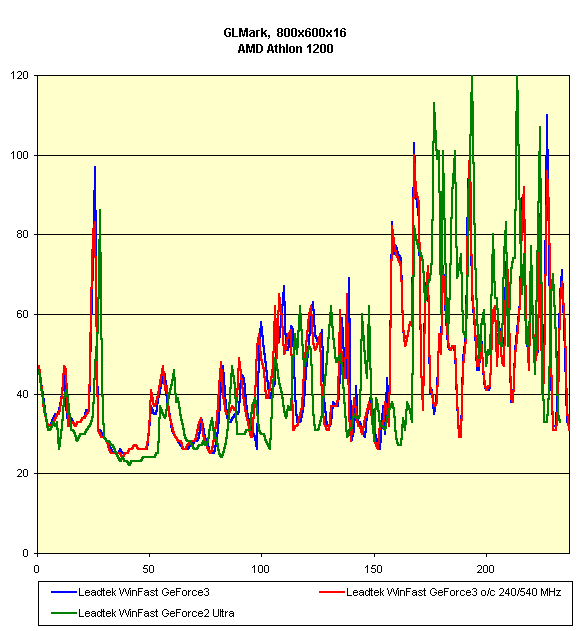  You can see that there is no difference between the the card's operation at the rated frequencies and when overclocked, the Leadtek WinFast GeForce2 Ultra is sometimes ahead of the GeForce3 card in 16-bit color. 1024X768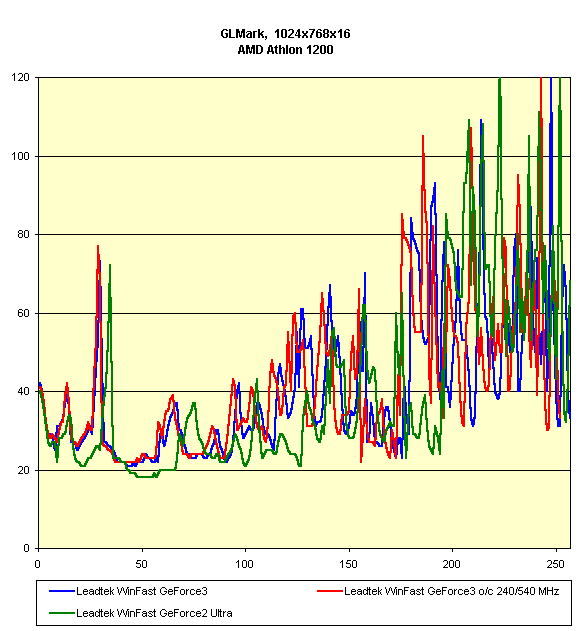 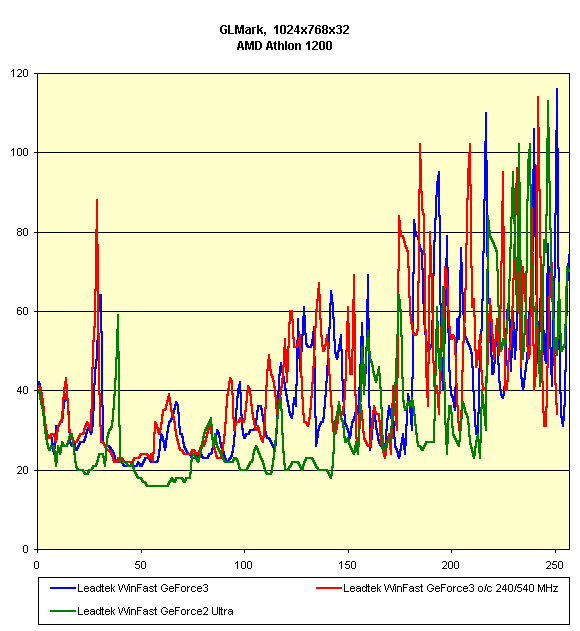 In 16-bit color the competition gets really messy, though sometimes the Leadtek WinFast GeForce2 Ultra still wins over the GeForce3. 1280X1024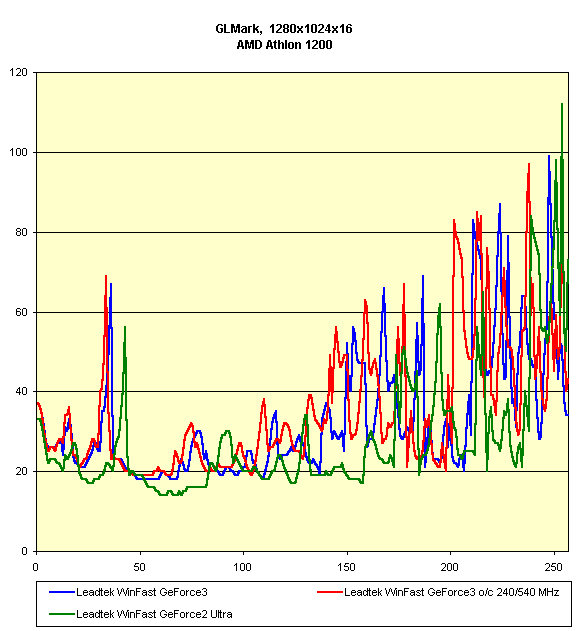 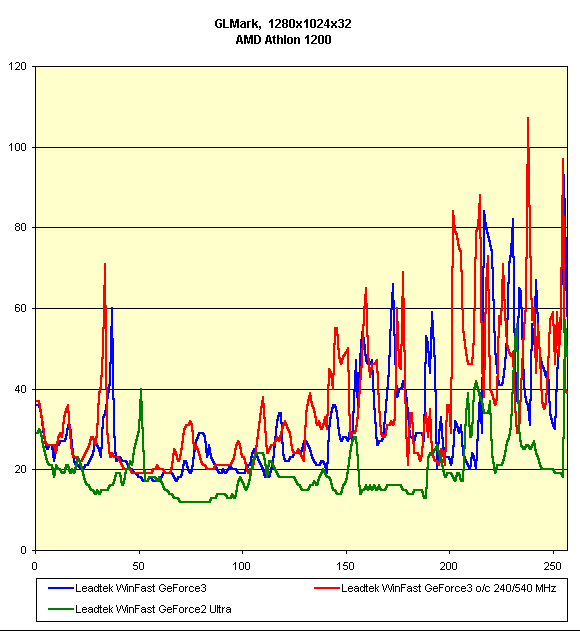 In this resolution the Leadtek WinFast GeForce2 Ultra lags behind the overclocked GeForce3. 1600X1200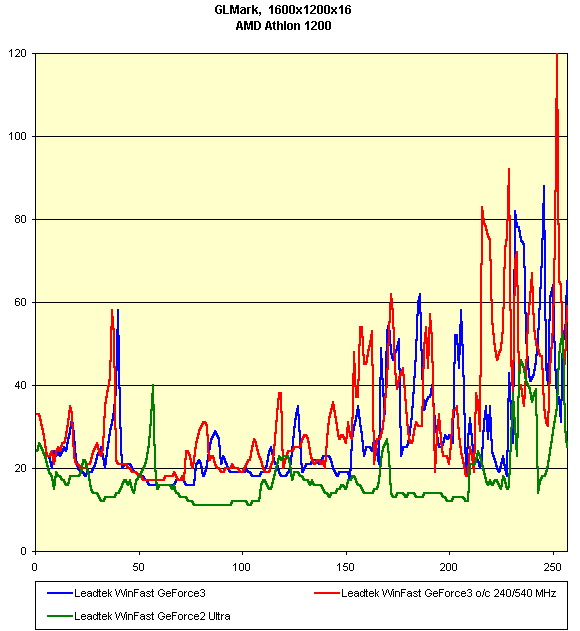  The situation is the same. The GLMark consists of two scenes: the first one, on a tropical island, is very complex since there are a great deal of objects and effects of the water surface. The second scene brings us inside some building like in the Unreal, therefore it is simpler. Despite the presence of EMBM effects, they don't load the card heavily, and on the whole the second part is easier for accelerators. These results supplement perfectly those obtained with the AquaNox in the previous article. Additional functionsThe card offers you also a WinFast DVD-player based on the WinDVD from InterVideo. 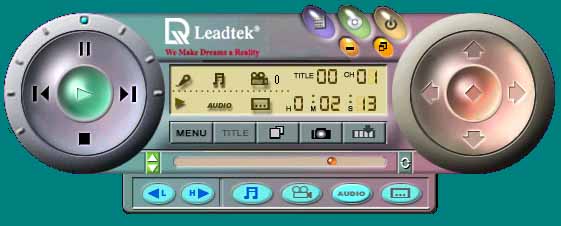 This player can work correctly with the GeForce3 and use all its hardware possibilities when decoding MPEG2. The CPU utilization constitutes only 21% and the image quality is very high:  ConclusionIt is a remarkable product; cards of this class can produce nearly all known 3D effects. That is why for gamers longing for perfect speed in 32-bit color and a heap of effects a purchase of such cards as Leadtek WinFast GeForce3 will satisfy all their demands and give the best performance in Truecolor. Besides, prices for such cards are gradually falling, and the Leadtek WinFast GeForce3 is in the vanguard of the cheap high quality cards. I think that for GeForce2 Ultra cards it is time to leave the market since very soon newer better accelerators will be priced even lower. Certainly, there are not many people with full wallets for such cards, but falling prices is a regular occurrence. However, before purchasing such a powerful accelerator you should make sure that your machine is equipped with a platform with a processor to match its power. It is clear that it makes no sense to install such video cards on a system with a processor less than 1 GHz, since it can cut the video card potential tremendously even in the popular resolution 1024X768. In our 3Digest you can find a full comparison of characteristics of cards of this and other classes. Highs:
Lows:
Write a comment below. No registration needed!
|
Platform · Video · Multimedia · Mobile · Other || About us & Privacy policy · Twitter · Facebook Copyright © Byrds Research & Publishing, Ltd., 1997–2011. All rights reserved. |